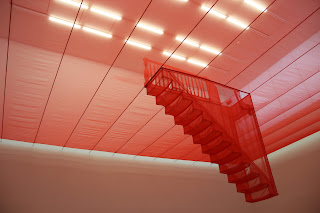On walking around the gallery I came across these thress images by Kiyohiko Komura.
The artworks are called:
Far Left: Two Abstract Forms, c1950
Centre: Work II, Female Body Composition, c1950
Right: Untitled, c1950
They are all gelatin silver prints on paper.
They were part of a section of the gallery called 'State of Flux- Japanese Photography and the Bauhaus.' I read that this room looked at the 'exchange of Avant- Garde photographic practices between Western Europe and the Far East, as photographers in Japan took up ideas associated with the modernist style of the Bauhaus. By reading this it gave me an introduction to the work of the photographers.
I like the consideration of the framing because although they are from different photographs, all the photographs in this section of the gallery are presented in the same way linking the Japanese Photography and the Bauhaus influences together with the work.
I liked the three pieces of work by Kiyohiko Komura, I liked there feel of experimenting and there simplicity. Also, I liked the way that they were created by overlaying negatives. I like that they are square, there tones of colours and that although they are photographic close- ups of anatomical forms it is not obvious what they are showing.
Also, in another area of the 'State of Flux- Cubism, Futurism, Vorticism' gallery was the work by Jenny Holzer. I was fascinated by her work because although I have previous studied/ been inspired by her work I had never seen it before outside of photographs.
 The piece of work was called 'Blue Purple Tilt'- 2007 by Jenny Holzer and it was seven double sided vertical LED signs which brighten a dark room. These signs had very powerful messages going across every single one at the same time. In my opinion most of the messages were negative but statements which made you think about what is going on around us. However, as a piece of work myself and others in the room were just sitting/ standing and reading what they were saying. I felt that this was another interesting way of presenting work because it got people discussing about what they were reading whether they agreed with it or not.
The piece of work was called 'Blue Purple Tilt'- 2007 by Jenny Holzer and it was seven double sided vertical LED signs which brighten a dark room. These signs had very powerful messages going across every single one at the same time. In my opinion most of the messages were negative but statements which made you think about what is going on around us. However, as a piece of work myself and others in the room were just sitting/ standing and reading what they were saying. I felt that this was another interesting way of presenting work because it got people discussing about what they were reading whether they agreed with it or not. Some of the statements read:
We must make sacrificies to maintain quality of life.
Some of your actions determine what you are.
Trading a life for a life is fair enough.
When something bad happens everybody wakes up.
The only way to stay pure is to stay by yourself.
Both the works from the artist show different ways of communicating ideas and are presented in way which would not have been thought of as traditional.
Bibliography (Kiyohiko Komura):
Bibliography (Jenny Holzer):















